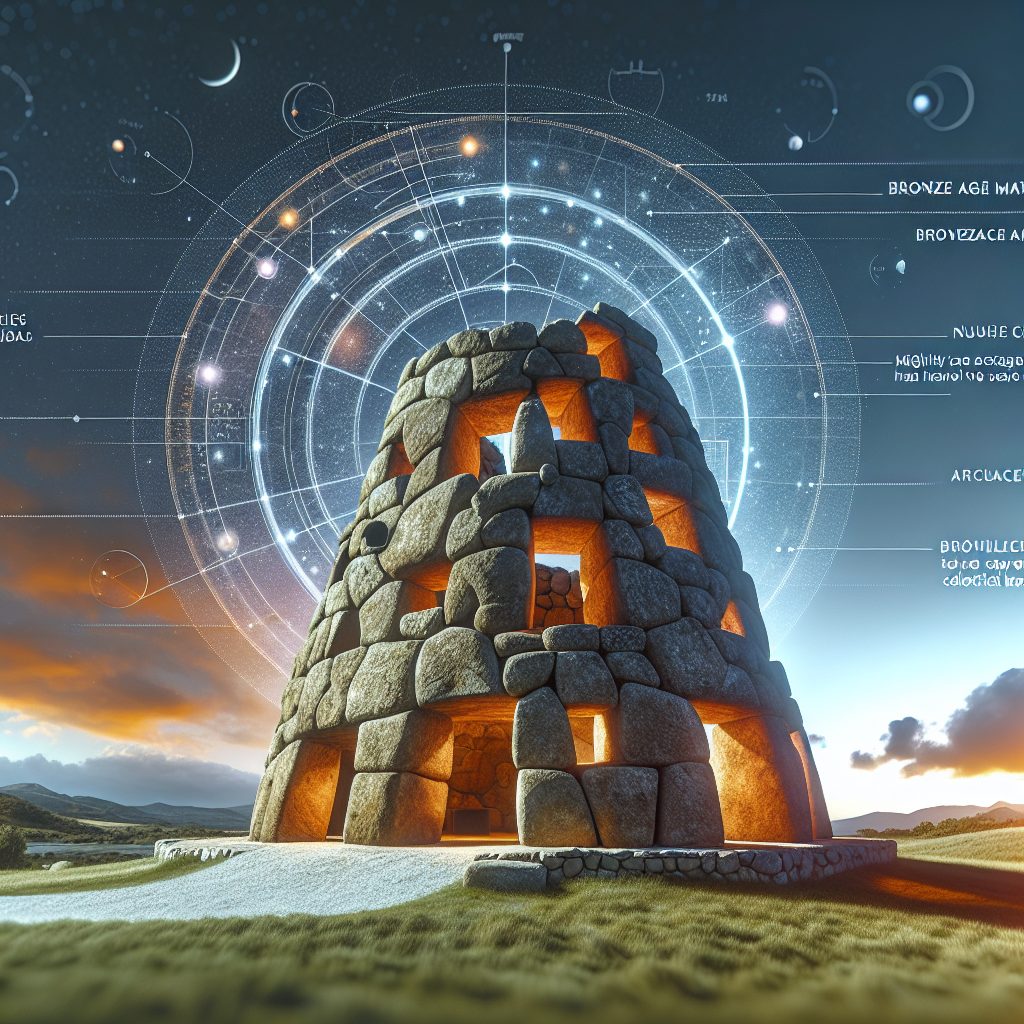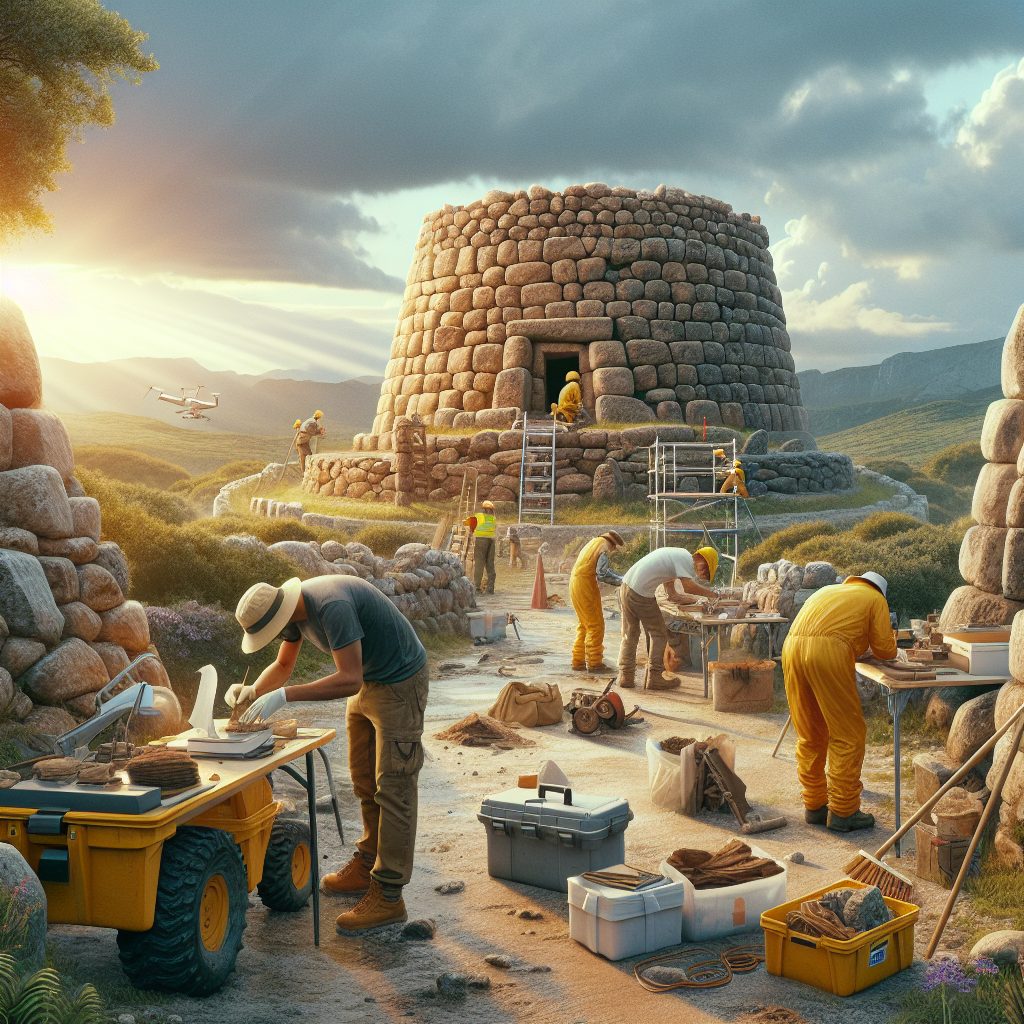Nuraghe, an intriguing type of ancient stone structure found in Sardinia, Italy, has long fascinated archaeologists and astronomers alike. These majestic towers, believed to have been built by the Nuragic civilization during the Bronze Age, posses unique characteristics that suggest they may have served as astronomical tools. With their distinctive shape and strategic positioning, Nuraghe offer valuable insights into the ancient civilization’s connection with the celestial realm.
One remarkable feature of Nuraghe is their circular or truncated cone shape, often reaching impressive heights of up to 20 meters. These structures were meticulously constructed using stone blocks, with some Nuraghe complexes comprising multiple towers. The precise architecture of these monuments suggests an advanced knowledge of engineering and construction techniques for the time. Additionally, many Nuraghe show signs of alignments with celestial bodies, such as the sun and moon, reinforcing the idea that they were intended to serve an astronomical purpose. Scholars believe that these ancient towers might have been used for observing celestial phenomena, tracking the movement of celestial bodies, or even predicting important astronomical events.
Moving forward, let us delve deeper into the key takeaways related to Nuraghe as astronomical tools. We will explore the possible methodologies employed by the Nuragic civilization to align these structures with celestial markers, as well as the significance of such observations in their culture and daily lives. Furthermore, we will examine the challenges faced by archaeologists in unraveling the mysteries surrounding the Nuraghe, and the implications of their findings for our understanding of ancient astronomy. By the end of this article, you will gain a comprehensive perspective on how these enigmatic Nuraghe played a pivotal role in the Nuragic civilization’s fascination with the cosmos.
Key Takeaways
– Nuraghe, ancient stone structures found in Sardinia, were likely used as astronomical tools by the Nuragic civilization.
– Researchers have discovered alignments between nuraghe and celestial events, indicating the purpose of these structures was the observation and study of the stars.
– The alignment of nuraghe with the equinoxes and solstices suggests a deep understanding of celestial movements and the ability to accurately mark significant dates in the agricultural calendar.
– The nuraghe’s strategic geographical placement and specific construction techniques likely contributed to their astronomical functionality.
– Further research and analysis will continue to uncover the intricate astronomical knowledge possessed by the Nuragic civilization and shed light on their connection to the cosmos.
How can Nuraghe be used as Astronomical Tools?
Understanding Nuraghe: Ancient Sardinian Structures
Nuraghe refers to a type of megalithic structure found on the island of Sardinia, Italy. These impressive stone towers were built during the Nuragic Age, between 1900 and 730 BCE. Nuraghe structures are characterized by their distinct conical shape and were used for various purposes, including defense, dwelling, and religious practices. However, recent research suggests that these unique structures may have also served as astronomical tools.
Nuraghe Alignment with Celestial Bodies
One fascinating aspect of Nuraghe structures is their alignment with celestial bodies. Scholars have observed that some of these ancient towers were built in strategic positions, aligned with significant solar and lunar events. For example, certain Nuraghe structures are precisely oriented towards the sunrise or sunset during solstices and equinoxes, indicating a possible connection to celestial observations.
Possible Astronomical Functions of Nuraghe
While the exact purpose of Nuraghe as astronomical tools is still a subject of speculation, several theories have been proposed. Here are a few:
1. Lunar Observations
Some researchers suggest that Nuraghe structures were used to observe the moon’s movements. By tracking lunar cycles and phases, ancient communities could have developed calendars and associated rituals, helping them plan agricultural activities and religious ceremonies.
2. Solar Observations
Another hypothesis is that Nuraghe played a role in solar observations. The alignment of certain structures with specific solar positions could have enabled ancient astronomers to track the sun’s yearly journey, marking important dates for agricultural practices or significant celestial events.
3. Stellar Observations
There is also speculation that Nuraghe might have been utilized for observing stars. By pinpointing specific constellations and stars, these ancient structures could have aided in navigation, predictive astronomy, and possibly even celestial worship.
Modern Studies and Speculations
While the ancient Sardinians left no written records explaining the purpose of Nuraghe structures, modern studies and speculations have shed some light on their possible astronomical functions. Archaeoastronomy, a discipline that combines archaeology and astronomy, has played a crucial role in analyzing the alignment of Nuraghe with celestial bodies and exploring their significance.
Conclusion
In conclusion, Nuraghe structures serve as fascinating remnants of the ancient Sardinian civilization. While they were primarily used for defensive and domestic purposes, there is growing evidence to suggest that they also functioned as astronomical tools. The precise alignments of Nuraghe with celestial bodies indicate a possible connection to lunar, solar, and stellar observations. Further research and exploration into these ancient structures will continue to expand our understanding of their multifaceted roles.
- How to analyze the alignment of Nuraghe with celestial bodies?
- What tools were possibly used by ancient astronomers in Nuraghe?
- What other purposes might Nuraghe have served besides astronomical observations?
- Are there any similar structures found in other parts of the world?
- What impact did Nuraghe have on the daily lives of ancient Sardinians?
Frequently Asked Questions
1. What are Nuraghe as astronomical tools?
Nuraghe are ancient stone structures found in Sardinia, Italy, which were predominantly built during the Bronze Age. These structures are believed to have served various purposes, including functioning as astronomical tools for studying celestial phenomena.
2. How were Nuraghe used for astronomical observations?
Nuraghe were built with careful alignment to specific celestial features, such as solstices, equinoxes, and important stars. The openings and passages of these structures were designed to allow precise observation and measurement of these celestial events, aiding ancient astronomers in their studies.
3. What evidence supports the theory of Nuraghe being used as astronomical tools?
Archaeological findings and careful analysis of the orientation and alignment of Nuraghe structures provide evidence of their astronomical significance. Additionally, the discovery of various tools and artifacts associated with astronomical observation suggests that Nuraghe served as important observatories.
4. Were Nuraghe only used for observing celestial events?
While the primary purpose of Nuraghe seemed to be astronomical observation, it is believed that they also had cultural, religious, and possibly defensive functions. They were multi-purpose structures that reflected the complexity of the Bronze Age societies that built them.
5. How do Nuraghe compare to other ancient astronomical structures?
Nuraghe are unique to Sardinia and differ from other ancient astronomical structures, such as Stonehenge or the Mayan pyramids. While Stonehenge and the pyramids were aligned with specific celestial events, Nuraghe were built on an individual level, with various structures having different celestial alignments.
6. Can we still derive astronomical information from Nuraghe today?
Due to their archaeological and astronomical significance, Nuraghe continue to be researched extensively. By studying their alignments and the relationship between the structures and celestial events, astronomers gain insights into ancient astronomy, calendars, and cultural practices.
7. What is the historical significance of Nuraghe as astronomical tools?
The existence of Nuraghe as astronomical tools demonstrates the advanced knowledge and skills of the ancient civilizations that built them. It highlights the importance of celestial observation in ancient societies and provides a glimpse into their cultural, religious, and scientific practices.
8. Can Nuraghe help us understand ancient Sardinian civilization?
Yes, studying Nuraghe as astronomical tools helps us understand the beliefs, activities, and environmental understanding of ancient Sardinian civilization. It sheds light on their connection to the cosmos and how they incorporated astronomical knowledge into their daily lives.
9. How do researchers study Nuraghe as astronomical tools?
Researchers employ various techniques to study Nuraghe, including archaeological excavations, surveys, and measurements of alignments and celestial relationships. They use modern astronomical tools and computational methods to reconstruct and analyze ancient celestial events.
10. Are there any ongoing efforts to preserve and study Nuraghe?
Yes, there are ongoing efforts to preserve and study Nuraghe structures, considering their historical and cultural significance. Collaboration between archaeologists, astronomers, and conservationists is crucial to ensure the continued understanding and conservation of these unique astronomical tools.
Final Thoughts
The Nuraghe as astronomical tools are remarkable remnants of ancient civilizations. Their alignment with celestial events and careful construction provide insight into the advanced knowledge and skills of the Bronze Age societies. By studying these structures, researchers not only unravel the astronomical practices of the past but also gain a deeper understanding of the cultural, religious, and scientific aspects of the ancient Sardinian civilization. The preservation and continued study of Nuraghe are essential for preserving our human heritage and expanding our knowledge of our ancestors’ relationship with the cosmos.
Exploring the Nuraghe as astronomical tools is like peering into the ancient skylines of the past. These structures offer a captivating window into the minds and wisdom of our predecessors as they studied and contemplated the celestial wonders above. As we uncover more about the complex alignments and purposes of Nuraghe, we gain a renewed appreciation for the universal fascination and pursuit of astronomical knowledge that spans across time and cultures. The Nuraghe stand as silent guardians, reminding us of the enduring connection between humanity and the cosmos and urging us to continue exploring the mysteries of the universe.






